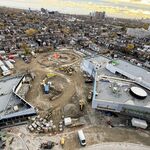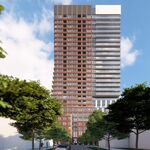Steve X
Senior Member
They'll just renumber it to Highway 10. Point is to reduce confusion for drivers not impress roadgeeks.It could become the 410A.
They'll just renumber it to Highway 10. Point is to reduce confusion for drivers not impress roadgeeks.It could become the 410A.
Neither of those numbers provides any useful information.These environmental groups seem to just be arguing for the sake of arguing.
According to them, the highway will 'pave over' 400 acres of Greenbelt. But of course what they don't tell you is that this is only 0.02% of the Greenbelt.
notably, it also only really crossing the greenbelt on small fingers of it running along river valleys. The vast vast majority of the highway runs through white-belt lands. You can see what I mean on the map posted on the last page below..These environmental groups seem to just be arguing for the sake of arguing.
According to them, the highway will 'pave over' 400 acres of Greenbelt. But of course what they don't tell you is that this is only 0.02% of the Greenbelt.

As far as I know there's little similarity with that figure and the Greenbelt - https://www.ontario.ca/page/greenbelt-mapsnotably, it also only really crossing the greenbelt on small fingers of it running along river valleys. The vast vast majority of the highway runs through white-belt lands. You can see what I mean on the map posted on the last page below.
All existing, expanded or new infrastructure subject to and approved under the Canadian Environmental Assessment Act, the Environmental Assessment Act, the Planning Act, the Aggregate Resources Act or the Telecommunications Act or by the National or Ontario Energy Boards, or which receives a similar environmental approval, is permitted within the Protected Countryside, subject to the policies of this section and provided it meets one of the following two objectives:
a) It supports agriculture, recreation and tourism, Towns/Villages and Hamlets, resource use or the rural economic activity that exists and is permitted within the Greenbelt; or
b) It serves the significant growth and economic development expected in southern Ontario beyond the Greenbelt by providing for the appropriate infrastructure connections among urban centres and between these centres and Ontario’s borders
The location and construction of infrastructure and expansions, extensions, operations and maintenance of infrastructure in the Protected Countryside are subject to the following:
a) Planning, design and construction practices shall minimize, wherever possible, the amount of the Greenbelt, and particularly the Natural Heritage System and Water Resource System, traversed and/or occupied by such infrastructure;
b) Planning, design and construction practices shall minimize, wherever possible, the negative impacts on and disturbance of the existing landscape, including, but not limited to, impacts caused by light intrusion, noise and road salt;
c) Where practicable, existing capacity and co-ordination with different infrastructure services shall be optimized so that the rural and existing character of the Protected Countryside and the overall hierarchy of areas where growth will be accommodated in the GGH established by the Greenbelt Plan and the Growth Plan are supported and reinforced;
d) New or expanding infrastructure shall avoid key natural heritage features, key hydrologic features or key hydrologic areas unless need has been demonstrated and it has been established that there is no reasonable alternative;
e) Where infrastructure does cross the Natural Heritage System or intrude into or result in the loss of a key natural heritage feature, key hydrologic feature or key hydrologic areas, including related landform features, planning, design and construction practices shall minimize negative impacts on and disturbance of the features or their related functions and, where reasonable, maintain or improve connectivity;
f) New or expanding infrastructure shall avoid specialty crop areas and other prime agricultural areas in that order of priority, unless need has been demonstrated and it has been established that there is no reasonable alternative;
g) Where infrastructure crosses prime agricultural areas, including specialty crop areas, an agricultural impact assessment or equivalent analysis as part of an environmental assessment shall be undertaken; and
h) New waste disposal sites and facilities, and organic soil conditioning sites are prohibited in key natural heritage features, key hydrologic features and their associated vegetation protection zones.
That's worse, because now we can build Milton next to the highway.notably, it also only really crossing the greenbelt on small fingers of it running along river valleys. The vast vast majority of the highway runs through white-belt lands. You can see what I mean on the map posted on the last page below..
Plus, the Greenbelt Plan itself actually has very explicit policies permitting things like infrastructure corridors. So the highway is in complete compliance with the Greenbelt Plan.

I'm all for reducing emissions and slowing down climate change, but building this highway (or any highway, for that matter) will not meaningfully contribute to an increase in emissions on a global scale.Well, perhaps a more useful number is 1.5 degrees C. I'm not sure how this highway helps us--and future generations--stay below that temperature increase.
It's lovely how proponents always pull this bag of facts out of the woodwork to support their opinions. How about studies that show living near highways has significant affects on health (neurological, respiratory, etc.)I'm all for reducing emissions and slowing down climate change, but building this highway (or any highway, for that matter) will not meaningfully contribute to an increase in emissions on a global scale.
Canada's global emissions contribution is somewhere around 1.5%, based on 2018 data. It is absolutely indisputable that we emit the most per capita, and we should absolutely be working to minimize industrial/electrical/transportation emissions for the sake of local quality of life, but it largely means nothing when China contributes almost 30%, the US around 15%, the EU around 9%, India around 7%, and Russia around 5%. China's entire transportation sector apparently produces more than double the emissions of our whole country, and the US's more than quadruple, according to this chart:
View attachment 360983
Ultimately, deciding whether or not to build a 52km highway in a province of 15M, in a country where most of our electricity is produced emission-free, gas/diesel vehicles will be banned from sale in 2035, environmental assessments are required to build almost anything, and building codes have energy efficiency standards, is not meaningfully or realistically going to slow down climate change when only 5 countries (counting the EU as a "country") with a combined population of over 3.7B contribute to over 50% of global emissions. This highway will, however, change the dynamic for these areas on a local level and that is what needs to be focused on now that it looks like the highway is most likely going ahead. Halton, Brampton, Caledon, and Vaughan all need to now be heavily pressured to plan appropriately to make productive, diverse, transit-friendly, relatively dense, and green-conscious use of these last bits of developable lands in the GTA.
Is there an issue with backing up an opinion with relevant facts that contribute to the discussion, even if my opinion is for construction of the highway?It's lovely how proponents always pull this bag of facts out of the woodwork to support their opinions. How about studies that show living near highways has significant affects on health (neurological, respiratory, etc.)
Building inside what we have, and leaving the land to be something other than a sea of asphalt, is even better than a freeway.Those studies are great points and raise valid concerns, but I would argue that these issues are much more likely to arise from Toronto's contested stroads, as opposed to our freeways, since much of our highway corridors directly border industrial/commercial/hydro lands, with many exceptions. I would also argue that emission standards on light vehicles have greatly improved since the study period in the neurological study, which used info from 1994 to 2003.
Thanks for the strawman.I don't believe there was ever this level of high-profile public opposition to the 407 East project where 65km of highway was built, with half of it mostly being through full greenbelt lands, as opposed to just small fingers of it like here with the 413. While a large number of sprawl concerns with these highway projects are absolutely valid, the way I see it is that general environmental blanket statements and out-of-context emissions data are being used as a facade for what is largely a NIMBY-focused battle.
The 427 extension opened two months ago, and I'd argue that expanded arterials can handle the truck traffic and send it onto the 427, which will get to commercial and the 401 faster. If you told me Coleraine and Hwy 50 were being expanded, I would not oppose it (unless there were sprawl proposals directly related to the arterial expansion) - especially if we get guarantees that there won't be more residential in the area.At the end of the day, the GTA is going to have an additional 2.9 million people in it by 2046. These people are all going to be producing emissions regardless of how they get around. Ideally, we should be fitting these new people within the existing developed lands of the GTA and densifying. However, no matter how dense we go, it is not going to slow down the demand for new industrial land, which gets tighter as older industrial lands get redeveloped into denser mixed-use, and we see these developments increasingly forced out from the traditional cores of the GTA. This is where the the 413 is going to become really crucial.
I looked at that Greenbelt expansion map, which leaves out the area around the highway. Besides, we all know that Dougie will water it down for the developers.What I have ultimately wanted to see with this project is an appropriate environmental assessment process to fully outline exactly what environmental sensitivities and risks we will be dealing with, as well as additional environmental protections on other areas as compensation for building the highway We are already seeing the government working on expanding the Greenbelt westward and improving river valley protections within. I am hopeful that their completed environmental assessment produces some solid information and presents appropriate solutions to ease everyone's concerns.




